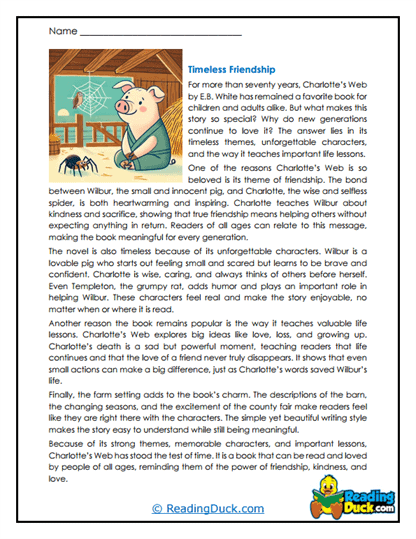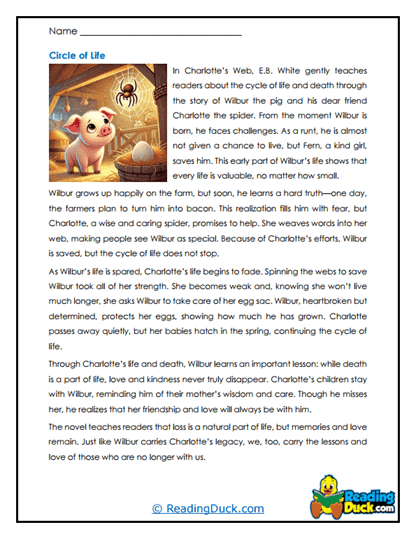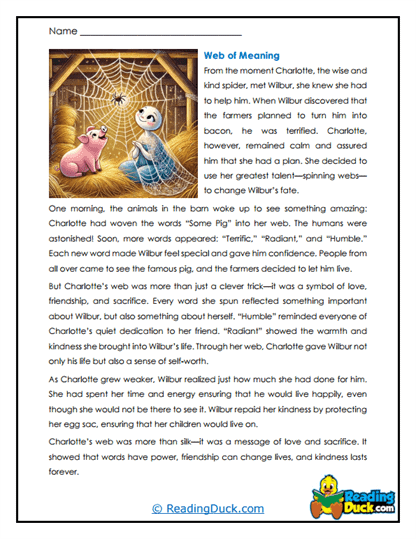Charlotte's Web Worksheets
About Our Charlotte's Web Worksheets
Our collection of reading comprehension worksheets is designed to help students develop key reading skills while engaging with the themes and characters of Charlotte's Web. The worksheets feature passages inspired by the events, dialogues, and lessons in the novel, allowing students to explore different aspects of the story in a structured and interactive way. By presenting content in manageable sections, students can focus on understanding one passage at a time, preventing them from feeling overwhelmed while still deepening their comprehension skills.
Each passage is crafted to highlight an important element of the story, such as friendship, perseverance, or kindness. After reading, students answer a variety of comprehension questions that encourage them to reflect on the text, analyze character motivations, and identify key details. The questions range from basic recall questions that test memory and attention to detail, to more analytical questions that require students to make inferences and draw conclusions. By engaging with these questions, students practice thinking beyond the surface level of a story and develop stronger analytical skills.
The passages help students build confidence in their reading abilities. Many young readers struggle with fluency, which can make comprehension difficult. By working through structured worksheets, students can practice reading fluently, recognizing sentence structures, and understanding how different parts of a passage connect. This process not only strengthens comprehension but also encourages students to approach reading with enthusiasm rather than apprehension. When students feel confident in their reading skills, they are more likely to develop a lifelong love for literature.
Our Charlotte's Web reading comprehension worksheets are carefully crafted to engage young readers and strengthen their understanding of key literary elements. Reading comprehension is a fundamental skill that students must develop to become proficient readers, and using a beloved classic like Charlotte's Web makes this process both enjoyable and meaningful. The worksheets are designed to help students analyze character development, identify themes, infer deeper meanings, and expand their vocabulary, all while staying engaged with the heartwarming story of Wilbur and Charlotte. By breaking down the novel into manageable passages and guided questions, these worksheets ensure that students grasp essential concepts without feeling overwhelmed.
Each worksheet contains a short passage inspired by events, characters, or themes from Charlotte's Web. These passages serve as mini-excerpts that capture important moments from the story, allowing students to focus on specific details and literary elements. By isolating key events, students can better analyze their significance without being distracted by the broader complexities of the full novel. This method is particularly useful for young readers who are still developing their comprehension skills, as it provides them with digestible chunks of text to work with. The passages are carefully selected to highlight key themes such as friendship, perseverance, kindness, and the passage of time, making them not only educational but also deeply meaningful.
Following each passage, students answer comprehension questions that test their ability to recall details, infer meaning, and analyze character actions. These questions are structured to assess different levels of understanding, from basic recall of events to higher-order thinking skills. For example, some questions might ask students to summarize what happened in the passage, while others might challenge them to interpret why a character behaved a certain way. By including a mix of literal and inferential questions, these worksheets encourage students to think critically about the text and engage with it on a deeper level. This practice not only strengthens comprehension but also helps students develop the analytical skills they will need for more advanced reading in the future.
To further encourage deeper engagement with the text, the worksheets include critical thinking prompts that ask students to reflect on the story's lessons and relate them to their own lives. These prompts encourage personal connections to the story, making literature more meaningful and relevant. For example, a student might be asked, "Have you ever had a friendship as strong as Wilbur and Charlotte's? How did that friendship impact you?" Such questions push students beyond simple text analysis and into real-world application, helping them see the value of literature in their daily lives. These critical thinking activities foster empathy, self-reflection, and a deeper appreciation for storytelling, which are all crucial components of a well-rounded literacy education.
By combining these elements-short passages, comprehension questions, vocabulary exercises, and critical thinking prompts-these worksheets provide a structured approach to reading comprehension while keeping learning enjoyable. Many students struggle with reading comprehension because they feel overwhelmed by large texts, but these worksheets break the story into manageable, engaging sections. This makes it easier for students to focus on key elements without feeling lost or discouraged. The structured format also ensures that all important aspects of literacy development are addressed, from basic recall to deeper analysis and personal reflection.
Summary of Charlotte's Web
Wilbur is a small pig who lives on a farm. At first, a kind girl named Fern saves him from being killed because he is the runt of the litter. She loves him and takes care of him.
Wilbur grows bigger and moves to a barn. There, he meets many animals, but his best friend is Charlotte, a smart and kind spider. Wilbur is happy, but he soon learns that the farmer plans to turn him into bacon!
Charlotte wants to save Wilbur. She spins words into her web, like "Some Pig" and "Terrific", to make him special. People come from all over to see the amazing pig. Because of Charlotte's clever plan, Wilbur's life is spared!
Charlotte becomes weak and dies, but she leaves behind her baby spiders. Wilbur loves them and remembers Charlotte's kindness.
The story teaches us about friendship, love, and helping others.









